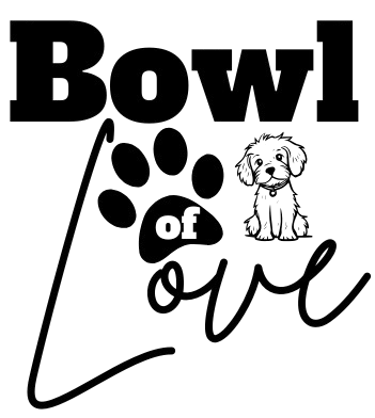Cooking for Dogs 101
Blog post description.Essential Safety Guidelines and Ingredient Restrictions for Homemade Pet Meals
DOG NUTRITION TIPS
9/30/202513 min read
Many dog owners want to prepare fresh, homemade meals for their pets but worry about making nutritional mistakes or using harmful ingredients. Cooking for dogs requires understanding their unique dietary needs, avoiding toxic foods like onions and chocolate, and using safe preparation methods that preserve nutrients without adding dangerous seasonings.
Homemade dog food can provide better ingredient control and fresher nutrition than commercial options when done correctly. The process involves learning which cooking methods retain the most nutrients, how to balance proteins and vegetables, and understanding portion sizes for different dog breeds and ages.
This guide covers essential safety protocols, identifies ingredients that can harm dogs, and explains proper cooking techniques to create nutritious meals. Pet owners will also learn how to transition their dogs to homemade food safely and recognize signs that indicate whether their dog is thriving on a new diet.
Understanding Canine Nutritional Needs
Dogs require six essential nutrients, specific portion sizes based on their weight and activity level, and dietary adjustments throughout different life stages. Adult dogs need 18-25% protein while puppies require 22-32% protein for proper growth.
Essential Nutrients for Dogs
Dogs need six fundamental nutrients to maintain optimal health. Protein serves as the primary building block for muscles, organs, and immune function.
Carbohydrates provide energy and support digestive health through fiber. Dogs can digest cooked grains, vegetables, and fruits effectively.
Fats supply concentrated energy and essential fatty acids. Omega-3 and omega-6 fatty acids maintain healthy skin and coat.
Water makes up 60-70% of a dog's body weight. Dogs need approximately 1 ounce of water per pound of body weight daily.
Vitamins regulate metabolic processes. Key vitamins include A, D, E, K, and B-complex vitamins.
Minerals support bone development and cellular function. Calcium, phosphorus, sodium, and potassium are particularly important.
Life Stage Dietary Requirements
Puppies require higher protein and fat content than adult dogs. Puppy food should contain 22-32% protein and 8-25% fat to support rapid growth.
Adult dogs need maintenance diets with 18-25% protein and 5-15% fat. Activity level determines the upper or lower end of these ranges.
Senior dogs benefit from easily digestible proteins and reduced calories. Many senior dogs require 20-25% fewer calories than active adults.
Pregnant and nursing females need puppy-formula food. Nursing mothers may require 2-4 times their normal caloric intake depending on litter size.
Portion Sizes and Caloric Intake
Most adult dogs need 20-30 calories per pound of body weight daily. Active dogs require the higher end while sedentary dogs need fewer calories.
Dog Weight Daily Calories Cup Measurement*
10 lbs 200-300 0.5-0.75 cups
25 lbs 500-750 1.25-1.75 cups
50 lbs 1000-1500 2.5-3.75 cups
75 lbs 1500-2250 3.75-5.5 cups
*Based on average dry food with 400 calories per cup
Divide daily portions into 2-3 meals for adult dogs. Puppies under six months need 3-4 smaller meals throughout the day.
Monitor body condition regularly. Dogs should have a visible waist when viewed from above and ribs that are easily felt but not visible.
Safety Rules for Cooking for Dogs
Proper hygiene practices and temperature control prevent foodborne illness in homemade dog meals. Cross-contamination between human and pet food preparation areas requires specific protocols to eliminate harmful bacteria transfer.
Safe Food Handling and Preparation
Temperature control forms the foundation of safe dog food preparation. Cook all meats to internal temperatures of 165°F for poultry and 160°F for ground meats. Use a digital thermometer to verify temperatures in the thickest part of the meat.
Wash hands thoroughly with soap for 20 seconds before and after handling raw ingredients. Clean all surfaces, cutting boards, and utensils with hot soapy water immediately after contact with raw proteins.
Fresh ingredients require immediate refrigeration below 40°F. Thaw frozen meats in the refrigerator rather than at room temperature to prevent bacterial growth.
Prepare dog food in small batches to maintain freshness. Cook vegetables until tender but avoid overcooking to preserve nutrients. Remove any bones, seeds, or pits that could pose choking hazards.
Preventing Cross-Contamination
Use separate cutting boards for raw meats and vegetables when preparing dog food. Designate specific utensils exclusively for pet food preparation to avoid mixing with human food prep tools.
Store raw dog food ingredients on the bottom shelf of the refrigerator. This prevents drippings from contaminating other foods below.
Clean preparation surfaces with a bleach solution after handling raw meats. Mix one tablespoon of bleach per gallon of water for effective sanitization.
Never prepare dog food on the same surfaces used for human meals without thorough cleaning between tasks. Wash dish towels and sponges regularly in hot water to eliminate bacteria buildup.
Proper Storage of Homemade Dog Food
Refrigerate cooked dog food within two hours of preparation. Store portions in airtight containers for up to three days in the refrigerator at temperatures below 40°F.
Freeze individual meal portions in freezer-safe containers for up to three months. Label containers with preparation dates to track freshness and rotate stock properly.
Thaw frozen dog food portions in the refrigerator overnight before serving. Never refreeze previously thawed dog food as this increases bacterial contamination risks.
Discard any uneaten wet dog food after 30 minutes at room temperature. Check stored food daily for signs of spoilage including off odors, mold growth, or unusual texture changes.
Ingredients to Avoid in Homemade Dog Food
Certain foods can cause serious health problems in dogs, from digestive upset to organ failure. Many common household ingredients, spices, and even healthy human foods can be toxic to canines.
Common Toxic Foods
Chocolate contains theobromine and caffeine, which dogs cannot metabolize effectively. Dark chocolate and baking chocolate pose the highest risk. Even small amounts can cause vomiting, diarrhea, seizures, and heart problems.
Grapes and raisins can cause kidney failure in dogs. The toxic compound remains unidentified, making any amount potentially dangerous. Symptoms include vomiting, lethargy, and decreased urination.
Onions and garlic damage red blood cells, leading to anemia. All forms are toxic, including powder, cooked, and raw varieties. Japanese breeds like Akitas and Shiba Inus show increased sensitivity.
Xylitol is an artificial sweetener found in sugar-free gum, candy, and baked goods. It causes rapid insulin release, leading to severe hypoglycemia within 30 minutes of consumption.
Harmful Additives and Spices
Salt in excessive amounts causes sodium poisoning. Dogs require minimal sodium compared to humans. High-sodium foods like processed meats and chips can lead to dehydration and kidney stress.
Nutmeg contains myristicin, which causes hallucinations, increased heart rate, and seizures in dogs. Even small amounts used in baking can be problematic.
Artificial preservatives like BHA, BHT, and ethoxyquin may cause allergic reactions and long-term health issues. These chemicals are often found in processed human foods.
High-fat seasonings and butter can trigger pancreatitis. Dogs cannot handle rich, fatty foods that humans typically enjoy. Stick to plain, unseasoned preparations.
Unsafe Fruits and Vegetables
Avocados contain persin, which causes digestive upset in dogs. The pit, skin, and leaves contain higher concentrations than the flesh.
Cherries have cyanide in their pits, stems, and leaves. The fruit itself can cause stomach upset due to its high sugar content.
Raw potatoes and potato skins contain solanine, especially when green or sprouted. Sweet potatoes are safe when cooked properly.
Mushrooms from the wild can be deadly. Store-bought varieties are generally safe, but it's better to avoid them entirely to prevent confusion.
Recommended Cooking Methods for Dog Meals
Gentle cooking methods preserve nutrients while ensuring food safety for canine consumption. Boiling, steaming, slow cooking, and baking eliminate harmful bacteria without requiring oils or seasonings that can harm dogs.
Boiling and Steaming
Boiling provides the safest method for preparing protein sources like chicken, turkey, and fish for dogs. Water temperatures of 212°F kill bacteria, parasites, and other pathogens that could cause digestive issues.
Boiling Times for Common Proteins:
Chicken breast: 15-20 minutes
Ground turkey: 8-10 minutes
White fish fillets: 6-8 minutes
Sweet potatoes: 20-25 minutes
Steaming preserves more vitamins than boiling since nutrients don't leach into cooking water. Steam vegetables like carrots, green beans, and broccoli for 5-8 minutes until tender.
Remove all bones before serving boiled meat to dogs. Cooked bones become brittle and can splinter, causing choking hazards or internal injuries.
Slow Cooking
Slow cookers break down tough cuts of meat into easily digestible meals for dogs. Cook on low heat for 6-8 hours to ensure proteins reach safe internal temperatures.
Add water to cover ingredients completely. This prevents burning and creates a broth that many dogs enjoy mixed with their kibble.
Safe slow cooker combinations include:
Chicken thighs with sweet potatoes and peas
Lean beef with carrots and rice
Turkey with pumpkin and green beans
Never add onions, garlic, or salt to slow cooker meals. These ingredients are toxic to dogs even in small amounts.
Baking Techniques
Baking requires no added fats, making it ideal for dogs with sensitive stomachs or weight management needs. Preheat ovens to 350°F for most dog-safe ingredients.
Wrap fish in parchment paper to retain moisture during baking. Salmon and cod fillets need 12-15 minutes depending on thickness.
Bake chicken breasts for 25-30 minutes until internal temperature reaches 165°F. Cut meat into appropriate sizes for the dog's breed and age before serving.
Root vegetables like carrots and parsnips become naturally sweet when roasted. Cut into uniform pieces and bake for 30-40 minutes until fork-tender.
Selecting Safe Ingredients for Homemade Dog Food
Quality ingredients form the foundation of nutritious homemade dog food. Dogs require high-quality proteins, digestible carbohydrates, and specific vegetables that provide essential nutrients without harmful compounds.
Protein Sources
Lean meats provide the most complete amino acid profiles for dogs. Chicken breast, turkey, and lean beef contain all essential amino acids dogs need for muscle development and maintenance.
Fish options like salmon, sardines, and mackerel deliver omega-3 fatty acids that support coat health and reduce inflammation. Remove all bones before serving fish to prevent choking hazards.
Eggs serve as an excellent protein source when cooked thoroughly. Raw eggs can contain salmonella and block biotin absorption. Scrambled or hard-boiled eggs work best.
Organ meats such as liver, kidney, and heart provide concentrated vitamins and minerals. Liver contains high levels of vitamin A, while heart muscle supplies taurine and CoQ10.
Protein Source Cooking Method Benefits
Chicken breast Boiled, baked Complete amino acids
Salmon Baked, steamed Omega-3 fatty acids
Liver Lightly cooked Vitamin A, iron
Eggs Scrambled, boiled High-quality protein
Complex Carbohydrates
Brown rice provides steady energy release and contains more fiber than white rice. It digests easily and rarely causes allergic reactions in dogs.
Sweet potatoes offer beta-carotene, fiber, and vitamins A and C. They must be cooked thoroughly and served without skin or seasonings.
Quinoa contains complete proteins and essential amino acids. This grain alternative works well for dogs with wheat sensitivities.
Oats supply soluble fiber that supports digestive health. Steel-cut oats provide better nutrition than instant varieties. Cook oats in water without milk or sweeteners.
Pumpkin aids digestion and provides fiber for dogs with stomach issues. Use plain canned pumpkin or fresh cooked pumpkin, never pumpkin pie filling.
Beneficial Vegetables
Carrots contain beta-carotene and provide natural sweetness dogs enjoy. Steam or boil carrots until soft to improve digestibility and nutrient absorption.
Green beans offer vitamins K and C plus fiber. Fresh or frozen green beans work well when steamed. Avoid canned varieties with added sodium.
Broccoli provides vitamin C and antioxidants but should comprise less than 10% of the meal. Too much broccoli can cause gastric irritation in sensitive dogs.
Spinach delivers iron and vitamins but contains oxalates that can interfere with calcium absorption. Use spinach sparingly and avoid it for dogs prone to kidney stones.
Zucchini adds moisture and fiber while being low in calories. This vegetable works well for overweight dogs needing portion control.
Adapting Recipes for Special Diets and Allergies
Dogs with food sensitivities require specific ingredient modifications to maintain optimal health. Alternative cooking approaches focus on eliminating problematic proteins, grains, and high-fat components while preserving nutritional balance.
Grain-Free Cooking
Grain-free recipes substitute wheat, corn, and rice with vegetables and alternative carbohydrates. Sweet potatoes, pumpkin, and butternut squash provide fiber and nutrients without triggering grain sensitivities.
Primary grain substitutes include:
Sweet potatoes (cooked and mashed)
White potatoes (peeled and boiled)
Pumpkin puree (plain, not spiced)
Green peas (fresh or frozen)
Coconut flour and almond flour work as binding agents in homemade treats. Use these sparingly since they concentrate calories and fats.
Hypoallergenic Ingredient Choices
Novel protein sources reduce allergic reactions in sensitive dogs. Venison, duck, and rabbit proteins work well for dogs allergic to chicken, beef, or lamb.
Safe hypoallergenic proteins:
Venison (lean cuts)
Duck breast (skin removed)
Rabbit meat
Fish varieties (salmon, whitefish)
Single-ingredient recipes help identify trigger foods. Introduce one new protein at a time over 7-10 days while monitoring for reactions.
Avoid common allergens including dairy products, eggs, and soy. These ingredients appear in many commercial recipes but trigger sensitivities in susceptible dogs.
Limited ingredient cooking reduces exposure risks. Combine one protein source with one carbohydrate and one vegetable for elimination diet protocols.
Low-Fat Recipes for Sensitive Dogs
Dogs with pancreatitis or digestive issues require fat content below 10% of total calories. Remove skin from poultry and trim visible fat from all meats before cooking.
Steam or boil proteins instead of roasting or frying. These cooking methods eliminate added fats while maintaining protein integrity.
Low-fat cooking techniques:
Steaming chicken breast pieces
Boiling lean ground turkey
Poaching white fish fillets
Baking vegetables without oil
Replace high-fat ingredients with lean alternatives. Substitute Greek yogurt for cream cheese and use low-sodium broth instead of butter for moisture.
Measure portions carefully since even low-fat foods contribute to daily fat intake. Calculate total fat grams per serving to maintain therapeutic levels prescribed by veterinarians.
Monitor dogs closely when transitioning to low-fat diets. Gradual changes over 5-7 days prevent digestive upset while allowing adaptation to new ingredient profiles.
Safe Treats and Snacks for Dogs
Dog owners can create nutritious homemade treats using basic ingredients like sweet potatoes and carrots. Many commercial dog snacks contain excessive sodium and preservatives that limit their daily feeding amounts.
Simple Homemade Treat Ideas
Baked sweet potato slices make excellent low-calorie treats. Owners should slice sweet potatoes into quarter-inch rounds and bake at 250°F for 3 hours until dehydrated.
Frozen banana pieces provide natural sweetness and potassium. Dogs should receive only small portions since bananas contain natural sugars.
Plain cooked chicken breast cut into small cubes offers high protein rewards. The chicken must be unseasoned and completely cooled before serving.
Carrot sticks serve as crunchy, low-calorie options that help clean teeth. Baby carrots work well for smaller dogs, while large dogs can handle full-sized carrots.
Ice cubes made from low-sodium chicken broth create refreshing summer treats. Owners should use broth without onion or garlic ingredients.
Limitations on Store-Bought Snacks
Commercial dog treats often contain high sodium levels that restrict daily portions. Most veterinarians recommend limiting store-bought treats to 10% of a dog's daily caloric intake.
Artificial preservatives like BHA and BHT appear in many commercial snacks. These chemicals help extend shelf life but provide no nutritional benefits.
Added sugars and corn syrup increase calorie content without essential nutrients. Dogs do not require added sugars in their diet.
Grain-free labels do not guarantee healthier options. Some grain-free treats contain higher fat content than traditional formulas.
Owners should read ingredient lists carefully and choose treats with five or fewer recognizable ingredients.
Monitoring Your Dog's Health When Feeding Homemade Meals
Watch for physical symptoms like weight changes, digestive issues, and coat problems that indicate nutritional deficiencies. Schedule veterinary visits every 6-12 months to track blood work and overall health status.
Signs of Nutritional Imbalance
Weight fluctuations often appear first when dogs receive inadequate or excessive calories. Sudden weight loss may indicate protein deficiency or insufficient total calories.
Rapid weight gain suggests too many calories or carbohydrates. Monitor your dog's body condition weekly by feeling for rib coverage and waist definition.
Digestive problems include loose stools, constipation, or frequent vomiting. These symptoms can result from sudden diet changes or ingredient intolerances.
Persistent diarrhea lasting more than 48 hours requires immediate attention. Normal stools should be firm and well-formed.
Coat and skin changes reflect nutritional status within 4-6 weeks. Dull, brittle fur often indicates inadequate protein or essential fatty acids.
Excessive shedding, dry skin, or hot spots may signal vitamin deficiencies. A healthy coat appears shiny and feels soft to touch.
Energy level shifts include lethargy, hyperactivity, or behavioral changes. Low energy can indicate insufficient B vitamins or iron deficiency.
Regular Veterinary Checkups
Schedule comprehensive blood panels every 6 months during the first year of homemade feeding. These tests measure protein levels, liver function, and kidney health.
Annual panels suffice once your dog's health stabilizes on the new diet. Request complete blood count, chemistry panel, and urinalysis for thorough assessment.
Weight monitoring should occur at each veterinary visit. Professional scales provide accurate measurements compared to home estimates.
Your veterinarian can assess body condition score objectively. They identify weight trends before they become problematic.
Nutritional consultation with a veterinary nutritionist helps optimize homemade recipes. Many general practitioners lack specialized nutrition training for diet formulation.
Bring detailed food logs including ingredients, quantities, and preparation methods. Professional analysis ensures your dog receives complete nutrition for long-term health.
Storing and Serving Homemade Dog Food
Fresh homemade dog food requires proper refrigeration within two hours of cooking. Store meals in airtight containers in the refrigerator for up to three days.
For longer storage, freeze portions in individual serving sizes. Frozen homemade dog food maintains quality for up to three months when stored at 0°F or below.
Safe Storage Guidelines:
Storage Method Duration Temperature
Refrigerator 3 days 40°F or below
Freezer 3 months 0°F or below
Room temperature 2 hours max N/A
Thaw frozen portions in the refrigerator overnight. Never thaw dog food at room temperature or in warm water, as this promotes bacterial growth.
Serve food at room temperature or slightly warm. Test temperature with a finger before serving to ensure it feels comfortable.
Portion Control Tips:
Use measuring cups for consistent serving sizes
Divide daily food requirements into two or three meals
Adjust portions based on dog's age, weight, and activity level
Clean food bowls thoroughly after each meal with hot, soapy water. Stainless steel or ceramic bowls work best for homemade food.
Remove any uneaten food after 30 minutes to prevent spoilage. Dogs should not have access to food that has been sitting out for extended periods.
Label containers with preparation dates to track freshness. Use oldest portions first to maintain proper food rotation.
Transitioning Your Dog to Home-Cooked Meals
Dogs need a gradual transition when switching from commercial food to home-cooked meals. An abrupt change can cause digestive upset, including diarrhea and vomiting.
The transition should take 7-10 days minimum. Some dogs with sensitive stomachs may need up to two weeks.
Week 1 Transition Schedule:
Days Commercial Food Home-Cooked Food
1-2 75% 25%
3-4 50% 50%
5-6 25% 75%
7+ 0% 100%
Start by mixing small amounts of home-cooked food with their regular kibble. Monitor the dog's stool consistency and energy levels throughout the process.
If digestive issues occur, slow down the transition. Return to the previous ratio for a few more days before advancing.
Dogs with food allergies or medical conditions require veterinary supervision during the transition. Their bodies may react differently to new ingredients.
Keep meals simple during the transition period. Use basic proteins like chicken or turkey with rice or sweet potato.
Watch for signs of food intolerance: loose stools, excessive gas, vomiting, or decreased appetite. These symptoms indicate the transition is moving too quickly.
Once fully transitioned, maintain consistent meal times and portions. Dogs thrive on routine and predictable feeding schedules.


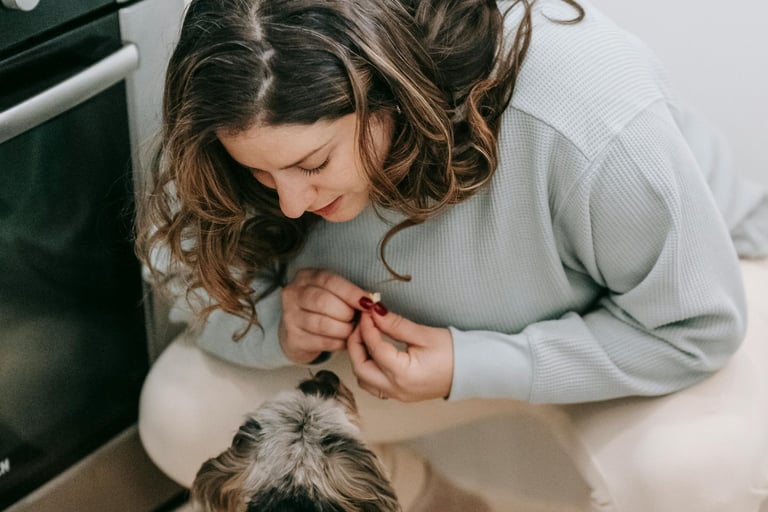



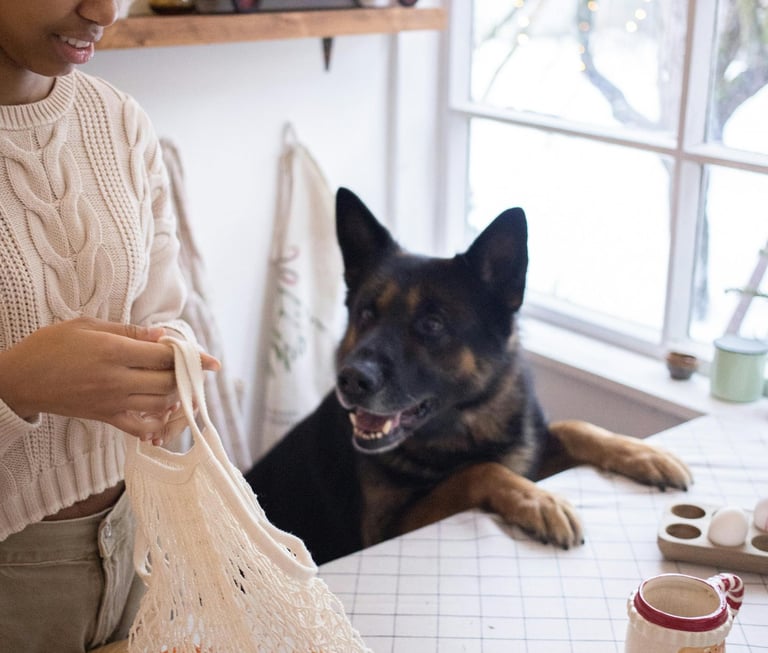

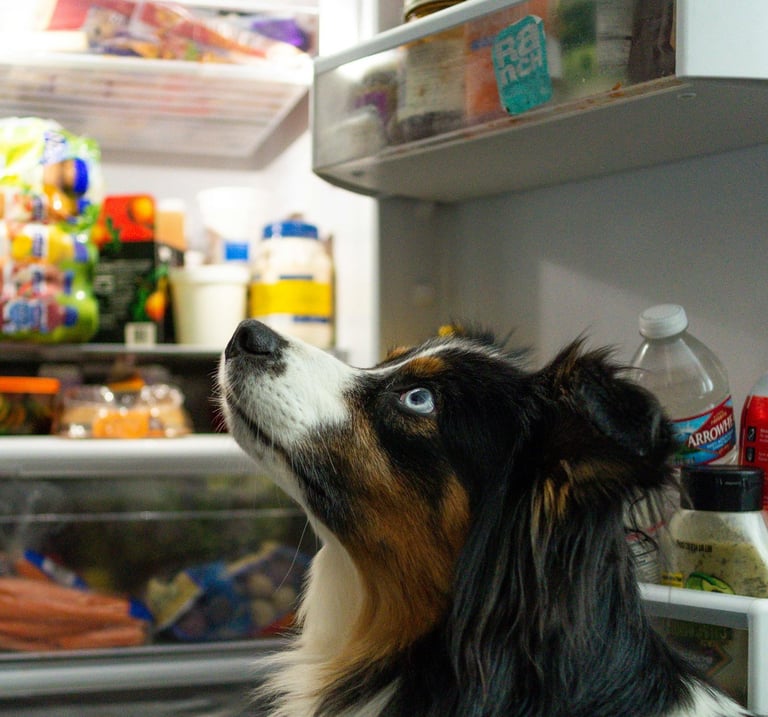

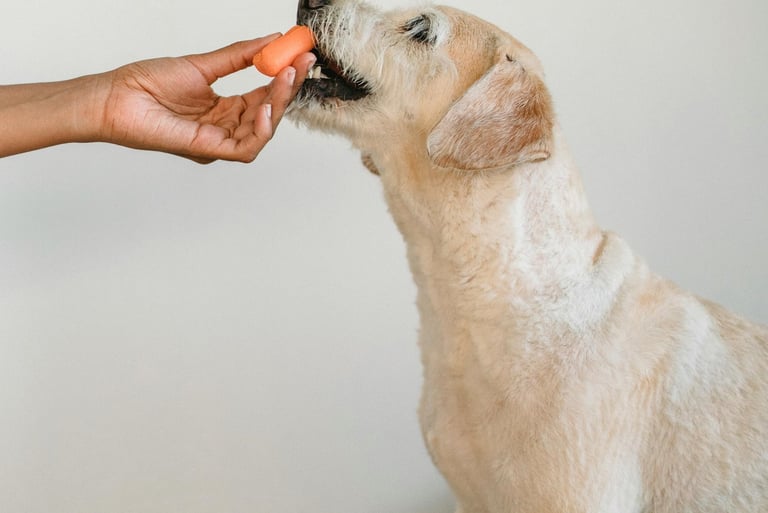



Check out our free healthy homemade food recipe booklet and more free resources in our store!
Connect
Reach out for support and inquiries.
Subscribe
contactbowloflove@gmail.com
© 2025. All rights reserved.
